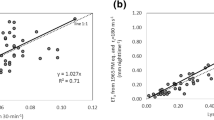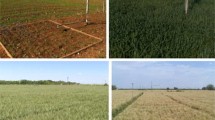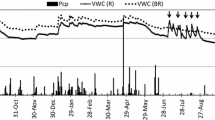Abstract
In a global scenario of climate change, water scarcity and population growth, it is imperative to optimize crop water management. One way is by calibrating a physically based crop evapotranspiration (ET) model, in the so-called one-step approach; as opposed to the two-step approach that uses reference evapotranspiration and crop coefficients. The Penman–Monteith (Symposium of the society for experimental biology, the state and movement of water in living organisms, Academic Press, Inc., New York; Monteith, Symposium of the society for experimental biology, the state and movement of water in living organisms, Academic Press, Inc., New York, 1965) ET model uses a bulk surface resistance (rs) term. This variable describes the resistance (stomatal, leaf, and canopy) to crop water transpiration and water evaporation from the soil surface. If the crop is not transpiring at a potential rate the rs resistance depends on the water status of the soil and vegetation. The stomatal resistance is influenced by climate and by water availability. However, this influence is different from crop to crop. The resistance increases when the crop is stressed and when the soil water availability limits ET. In this study, surface resistance was parameterized for grain maize considering a number of plant and environmental variables for water stressed and non-stressed conditions. The independent explanatory variables that facilitated a good calibration of rs, on a half-hourly basis, were: net radiation, photosynthetic active radiation, aerodynamic resistance, crop height, and leaf area index. The application of the obtained “rs” model (based on the variables mentioned above) resulted in maize ET (mm 30-min−1) estimation error of less than 1 ± 10% when evaluated with eddy covariance based ET data. This result is evidence that it is possible to calculate maize ET with a small associated error at very small time scales, for water deprived and advective conditions, using the one-step ET approach.

(adapted from NSIDC 2017). (Color figure online)
Similar content being viewed by others
References
Allen RG, Pereira LS, Raes D, Smith M (1998) Crop evapotranspiration: guidelines for computing crop water requirements. FAO Irrigation and Drainage, Paper 56. United Nations, FAO, Rome p 300
Anderson MC, Neale CMU, Li F, Norman JM, Kustas WP, Jayanthi H, Chavez J (2004) Upscaling ground observations of vegetation water content, canopy height, and leaf area index during SMEX02 using aircraft and Landsat imagery. Remote Sens Environ 92:447–464
Blonquist JM Jr, Norman JM, Bugbee B (2009) Automated measurement of canopy stomatal conductance based on infrared temperature. Agric For Meteorol 149:1931–1945
Brunsell NA, Gillies RR (2002) Incorporating surface emissivity into a thermal atmospheric correction. Photogramm Eng Remote Sens 68:1263–1269
Brutsaert W (1982) Evaporation into the atmosphere. Theory, history, and applications. Kluwer Academic Publishers, Dordrecht, The Netherlands
Bugbee B, Droter M, Monje O, Tanner B (1998) Evaluation and modification of commercial infra-red transducers for leaf temperature measurement. Adv Space Res 22:1425–1434
Burba G (2013) Eddy covariance method for scientific, industrial, agricultural, and regulatory applications. A field book on measuring ecosystem gas exchange and areal emission rates. LI-COR Biosciences, Lincoln
Caselles V, Coll C, Valor E (1997) Land surface emissivity and temperature determination in the whole HAPEX-Sahel area from AVHRR data. Int J Remote Sens 18:1009–1027
Chávez JL, Neale CMU, Hipps LE, Prueger JH, Kustas WP (2005) Comparing aircraft-based remotely sensed energy balance fluxes with eddy covariance tower data using heat flux source area functions. J Hydrometeorol 6(6):923–940
Chávez JL, Howell TA, Copeland KS (2009) Evaluating eddy covariance cotton ET measurements in a semiarid advective environment with large weighing lysimeters. Irrig Sci 28(1):35–50
Chávez JL (2015) Using canopy temperature as an indicator of plant stress. In: Proceedings of the 27th annual central plains irrigation conference (CPIC), Colby, KS
FAO (1986) Irrigation water management: irrigation water needs. Training manual no. 3. Eds. C. Brouwer and M. Heibloem. Food and Agriculture Organization of the United Nations, Rome
FAOSTAT (2016) FAO statistical database (online). http://www.fao.org/faostat/en/#data/QC. Accessed 14 May 2018
Foken T (2008) The energy balance closure problem: an overview. Ecol Appl 18:1351–1367
Gavilán PD (2002) La advección de calor sensible en el Valle Medio del Guadalquivir y su influencia en la medida y estimación de la evapotranspiración. Ph.D. dissertation, Córdoba University, Spain (in Spanish)
Gillies RR, Carlson T, Cui J, Kustas W, Humes K (1997) A verification of the ‘triangle’ method for obtaining surface soil water content and energy fluxes from remote measurements of the normalized difference vegetation index (NDVI) and surface radiant temperature. Int J Remote Sens 18:3145–3166
Irmak S, Mutiibwa D (2009) On the dynamics of stomatal resistance: relationships between stomatal behavior and micrometeorological variables and performance of Jarvis-type parameterization. Trans ASABE 52(6):1923–1939
Jensen ME, Burman RD, Allen RG (1990) Evapotranspiration and irrigation water requirements, in: ASCE manual and report on engineering practice No 70. ASCE, New York
Jiang X, Kang S, Tong L, Li F (2016) Modification of evapotranspiration model based on effective resistance to estimate evapotranspiration of maize for seed production in an arid region of northwest China. J Hydrol 538:194–207
Kriegler FJ, Malila WA, Nalepka RF, Richardson W (1969) Preprocessing transformations and their effects on multispectral recognition. In: Proceedings of the sixth international symposium on remote sensing of environment, pp 97–131
Kustas WP, Hatfield JL, Prueger JH (2005) The soil moisture–atmosphere coupling experiment (SMACEX): background, hydrometeorological conditions, and preliminary findings. J Hydrometeorol 6:791–804
Liengme B (2015) A guide to microsoft excel 2013 for scientists and engineers, 1st edn. Academic Press, Cambridge, 382 pp
López-Urrea R, Chávez JL (2018) One-step approach for estimating maize actual water use: part II. Lysimeter evaluation of variable surface resistance models. Irrig Sci. https://doi.org/10.1007/s00271-018-0607-7
Mcebisi M, Chávez JL, Allan A (2015) SEBAL-A: a remote sensing ET algorithm that accounts for advection with limited data. Part I: development and validation. Remote Sens 7(11):15046–15067
Monteith JL (1965) Evaporation and environment, In: Fogg GE (Ed.), Symposium of the society for experimental biology, the state and movement of water in living organisms. Academic Press, Inc., New York pp. 205–234
Mutiibwa D, Irmak S (2011) On the scaling up soybean leaf level stomatal resistance to canopy resistance for one-step estimation of actual evapotranspiration. Trans ASABE 54(1):141–154
Mutiibwa D, Irmak S (2013) Transferability of Jarvis-type models developed and re-parameterized for maize to estimate stomatal resistance of soybean: analyses on model calibration, validation, performance, sensitivity, and elasticity. Trans ASABE 56(2):409–422
NSIDC (2017) SMEX02 SMACEX tower meteorological/flux data: Iowa. Published on-line by National Snow and Ice Data Center. https://nsidc.org/data/docs/daac/nsidc0438_smex02_smacex_tower/pdfs/nsidc0438_smex02_smacex_tower.pdf. Accessed Jun 1 2017
Papaioannou G, Papanikolaou N, Retails D (1993) Relationships of photosynthetically active radiation and shorwave irradiance. Theor Appl Climatol 48:23–27
Rouse JW, Haas RH, Scheel JA, Deering DW (1974) Monitoring vegetation systems in the great plains with ERTS. In: Proceedings of 3rd earth resource technology satellite (ERTS) symposium. vol. 1, pp 48–62
Shuttleworth WJ (2006) Towards one-step estimation of crop water requirement. Trans ASABE 49(4):925–935
Shuttleworth WJ, Wallace JS (2009) Calculating the water requirements of irrigated crops in Australia using the Matt–Shuttleworth approach. Trans ASABE 52(6):1895–1906
Tolk JA (1992) Corn aerodynamic and canopy surface resistances and their role in sprinkler irrigation efficiency. Ph.D. dissertation. Texas Tech University
Tucker CJ (1979) Red and photographic infrared linear combinations for monitoring vegetation. Remote Sens Environ 8(2):127–150
Twine TE, Kustas WP, Norman JM, Cook DR, Houser PR, Meyers TP, Prueger JH, Starks PJ, Wesely ML (2000) Correcting eddy-covariance flux underestimates over a grassland. Agric For Meteorol 103:279–300
Valor E, Casselles V (1996) Mapping land surface emissivity from NDVI: application to European, African, and South American areas. Remote Sens Environ 57:167–184
Wilmott CJ (1982) Some comments on the evaluation of model performance. Bull Am Meteorol Soc 63:1309–1313
Yang Y, Su H, Zhang R, Wu J, Qi J (2013) A new evapotranspiration model accounting for advection and its validation during SMEX02. Adv Meteorol 2013:389568
Zhao WZ, Ji XB, Kang ES, Zhang ZH, Jin BW (2010) Evaluation of Penman–Monteith model applied to a maize field in the arid area of northwest China. Hydrol Earth Syst Sci 14:1353–1364
Acknowledgements
Financial support (Project # COL00688) received from Colorado Agricultural Experiment Station and the USDA National Institute for Food and Agriculture (NIFA) is greatly appreciated. R. López-Urrea acknowledges the financial support received from the Spanish Ministry of Education, Culture and Sports throughout the José Castillejo program (reference JC2015-00110) and from the Spanish Ministry of Economy and Competitiveness (Project AGL2014-54201-C4-4-R).
Author information
Authors and Affiliations
Corresponding author
Ethics declarations
Conflict of interest
On behalf of all authors, the corresponding author states that there is no conflict of interest.
Additional information
Communicated by R.G. Anderson.
Appendices
Appendices
Appendix A
Variables used in the Penman–Monteith equation (Monteith 1965).
-
1
Atmospheric pressure (P, in kPa) was calculated as follow: P = 101.3 × [(293 − 0.0065 × z)/293]5.26; z is the altitude in m (287 m).
-
2
Latent heat of vaporization (λ, in MJ kg−1) was estimated as function of Ta: λ = 2.501 − (2.361 × 10− 3) × Ta; Ta in °C.
-
3
Specific heat of the air at constant pressure (Cp, 1013 J kg−1 °C−1).
-
4
Psychrometric constant (γ, in kPa °C−1) was calculated as: γ = (cp × 10− 6 × P)/(0.622 × λ); cp, P and λ in the same units shown above.
-
5
Saturation vapor pressure (es in kPa) was estimated as: es = 0.6108 exp(17.27 × Ta/Ta + 237.3); es saturation vapour pressure at the air temperature (kPa), Ta air temperature (°C), exp(..) 2.7183 (base of natural log) raised to the power (..).
-
6
Actual vapor pressure (ea) was measured (kPa).
-
7
Slope of saturation vapor pressure curve (∆) was estimated as:
$$\Delta =\frac{{4098\left[ {0.6108\exp \left( {\frac{{17.27{T_{\text{a}}}}}{{{T_{\text{a}}}+237.3}}} \right)} \right]}}{{{{\left( {{T_{\text{a}}}+237.3} \right)}^2}}},$$where ∆ is the slope of saturation vapor pressure curve at air temperature T (kPa °C−1), Ta is the air temperature (°C), exp(..) 2.7183 (base of natural logarithm) raised to the power (..).
-
8
ρa is the mean air density at constant pressure (kg m− 3):
$${\rho _{\text{a}}}=\frac{P}{{1.01\left( {{T_{\text{a}}}+273} \right)R}},$$where P is the atmospheric pressure (kPa), Ta is the air temperature (°C), and R is the specific gas constant = 0.287 kJ kg−1 K−1.
-
9
zm is the height of wind measurements (m), 2 m above the corn height, since u was measured 2 m over the canopy by the 3D sonic anemometer of the EC system.
-
10
d is zero plane displacement height (m): d = 2/3 × hc.
-
11
The roughness length governing momentum transfer, zom (m) = 0.123 × hc.
-
12
zh is the height of humidity measurements: 2.5 m.
-
13
The roughness length governing transfer of heat and vapor, zoh (m), can be approximated by: zoh = 0.1 zom.
-
14
K is von Karman´s constant, 0.41 (−).
-
15
ra aerodynamic resistance (s m−1):
$${r_{\text{a}}}=\frac{{\ln \left( {\frac{{{z_{\text{m}}} - d}}{{{z_{{\text{om}}}}}}} \right)\ln \left( {\frac{{{z_{\text{h}}} - d}}{{{z_{{\text{oh}}}}}}} \right)}}{{{K^2}{u_z}}},$$where ra is the aerodynamic resistance (s m−1), zm is the height of wind measurements (m), zh is the height of humidity measurements (m), d is the zero plane displacement height (m), zom is the roughness length governing momentum transfer (m), zoh is the roughness length governing transfer of heat and vapor (m), K is the von Karman’s constant, 0.41 (−), uz is the wind speed at height z (m s−1).
Appendix B
See Table 7.
Appendix C
Rights and permissions
About this article
Cite this article
Chávez, J.L., López-Urrea, R. One-step approach for estimating maize actual water use: Part I. Modeling a variable surface resistance. Irrig Sci 37, 123–137 (2019). https://doi.org/10.1007/s00271-018-0606-8
Received:
Accepted:
Published:
Issue Date:
DOI: https://doi.org/10.1007/s00271-018-0606-8




